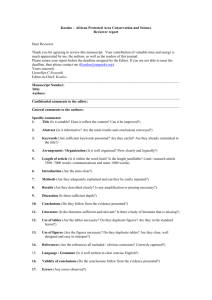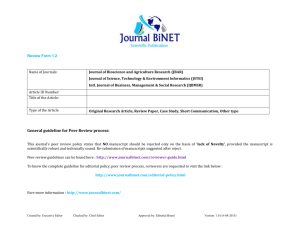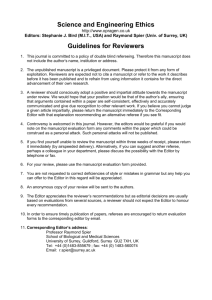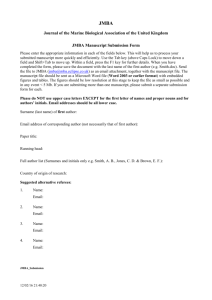How to Get Your Manuscript Published
advertisement
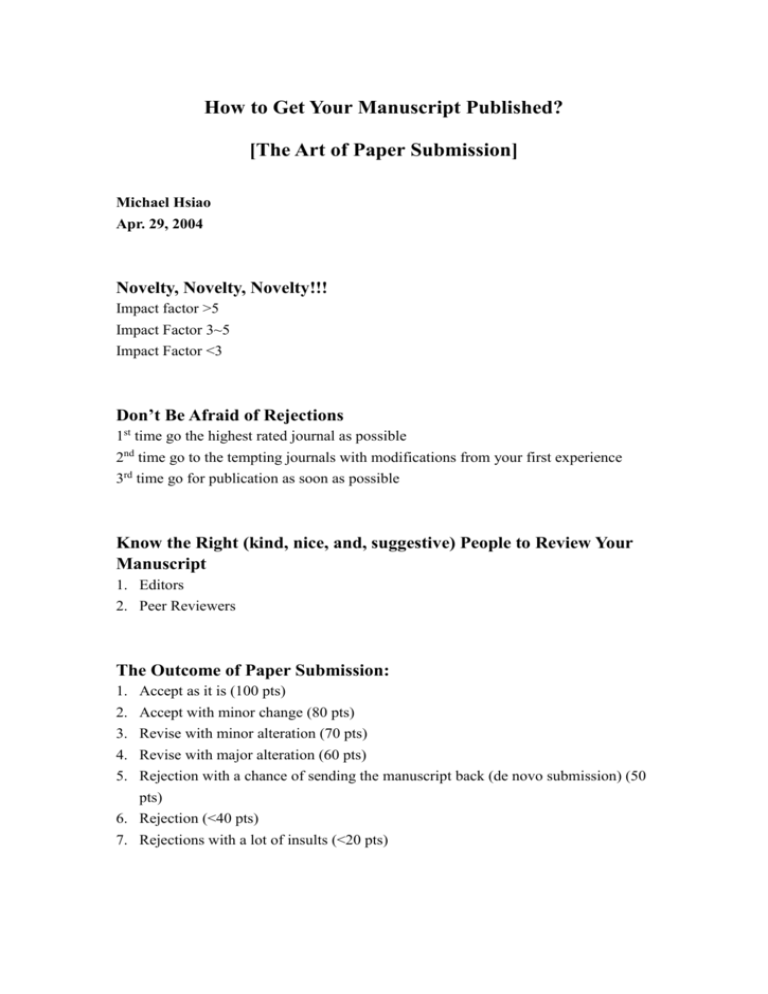
How to Get Your Manuscript Published? [The Art of Paper Submission] Michael Hsiao Apr. 29, 2004 Novelty, Novelty, Novelty!!! Impact factor >5 Impact Factor 3~5 Impact Factor <3 Don’t Be Afraid of Rejections 1st time go the highest rated journal as possible 2nd time go to the tempting journals with modifications from your first experience 3rd time go for publication as soon as possible Know the Right (kind, nice, and, suggestive) People to Review Your Manuscript 1. Editors 2. Peer Reviewers The Outcome of Paper Submission: 1. Accept as it is (100 pts) 2. Accept with minor change (80 pts) 3. Revise with minor alteration (70 pts) 4. Revise with major alteration (60 pts) 5. Rejection with a chance of sending the manuscript back (de novo submission) (50 pts) 6. Rejection (<40 pts) 7. Rejections with a lot of insults (<20 pts) Common Reasons for Rejection: Major reductions in Points (up to 10 points per mistake) 1. Send to the wrong journal 2. The results have been published before or even in a lower ranked journal 3. No new findings 4. Non-significant findings 5. Negative results 6. Technical: a. mistakes in data interpretations b. the data contradict to each other c. bad photo works, poor quality, d. wrong statistics (methods used, data analyzed…) e. English as a language barrier (DO NOT KNOW WHAT YOU’RE TALKING ABOUT, poor writing, wrong spelling, wrong grammar, wrong tense…) f. did not follow the instruction from the journal (total words, total figures numbers, references,…) 7. Reviewed by your competitors (OUCH!!!!!) How to Be Successful in Getting Your Manuscript Published Continuously? 1. Know the time frame of the journal turn-around time a. Less than 1.5 months for review comments back is preferred. Don’t send to a journal with more than 4 months turn-around time b. E-submission or paper submission? c. Be sure to get the Submission Number 2. Send to a journal you have true good friends there (chief editor, editor, reviewer) 3. Send to a journal that you can suggest your friends to be a reviewer 4. Send to a friendly journal again and again a. the editor know you after a while (who respects your track records, quality of works and will not treat you lightly) b. the reviewer knows who you are and also show respect for you c. the reviewer likes you to be on his side (gangs of scientists) 5. Send to a journal that may ask you to become the journal’s peer reviewer or even Editor 6. Distinguish between Journal’s Editorial Office [West Coast vs East Coast; U.S.A. vs Europe, Japan, or ROW (rest of the world)], a. b. c. d. East Coast: mean, hurtful West Coast: friendly; suggestive Europe: slow in process, picky on the English; Japan: fair treatment, English is always OK In Response to Editorial or Reviewer’s Comments: 1. Try to answer as sincere as possible 2. Do not fool around the issue (don’t offend the editor or the reviewer) 3. If you have no answer to the questions, be honest 4. Be very clear about the answer addressed with regard to where and how the changes were made 5. Be agreeable to the reviewer’s comments. Don’t fight with them unless you’re already in bad shape (They had the upper hand) OVERALL SUGGESTIONS 1. Prepare perfect manuscript, (technically perfect) 2. After you finished writing your READY-TO SUBMIT manuscript, please find someone in your organization or outside who are senior or with good reputation to have them have a quick look at your manuscript 3. Send to the correct address and the appropriate Editor. Be sure to obtain the Manuscript number. Need to provide the ABSOLUTELY CORRECT e-mail adress or fax number, and your name that is in charge of correspondence affairs. 4. Be sure to remind the Editor at the end of two months about the status of the manuscript 5. If rejected, a. Alter changeable comments and send the manuscript out right away to a lower rated journal b. Do experiments as suggested, finish the experiments within two months, and send to similar rated journals to look for a second chance 6. If De Novo, or revise with major revisions Absolutely drop all other on-going experiments to do the experiments as suggested by the reviewer. Answer as many questions as possible and re-submit the manuscript ASAP. (The Editor or the Reviewer may change their opinions about your manuscript if similar new papers published). 7. If Minor Revision, Make all the changes and send it back in less than two weeks to get the Acceptance Letter. 8. If Accepted, Open Champagne and celebrate!!!
